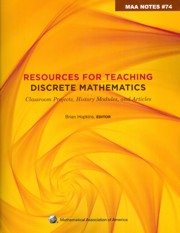Book contents
- Frontmatter
- Introduction
- Dedication
- Contents
- I Classroom-tested Projects
- II Historical Projects in Discrete Mathematics and Computer Science
- Introduction
- Binary Arithmetic: From Leibniz to von Neumann
- Arithmetic Backwards from Shannon to the Chinese Abacus
- Pascal's Treatise on the Arithmetical Triangle: Mathematical Induction, Combinations, the Binomial Theorem and Fermat's Theorem
- Early Writings on Graph Theory: Euler Circuits and The Königsberg Bridge Problem
- Counting Triangulations of a Convex Polygon
- Early Writings on Graph Theory: Hamiltonian Circuits and The Icosian Game
- Are All Infinities Created Equal?
- Early Writings on Graph Theory: Topological Connections
- A Study of Logic and Programming via Turing Machines
- Church's Thesis
- Two-Way Deterministic Finite Automata
- III Articles Extending Discrete Mathematics Content
- IV Articles on Discrete Mathematics Pedagogy
- About the Editor
Counting Triangulations of a Convex Polygon
from II - Historical Projects in Discrete Mathematics and Computer Science
- Frontmatter
- Introduction
- Dedication
- Contents
- I Classroom-tested Projects
- II Historical Projects in Discrete Mathematics and Computer Science
- Introduction
- Binary Arithmetic: From Leibniz to von Neumann
- Arithmetic Backwards from Shannon to the Chinese Abacus
- Pascal's Treatise on the Arithmetical Triangle: Mathematical Induction, Combinations, the Binomial Theorem and Fermat's Theorem
- Early Writings on Graph Theory: Euler Circuits and The Königsberg Bridge Problem
- Counting Triangulations of a Convex Polygon
- Early Writings on Graph Theory: Hamiltonian Circuits and The Icosian Game
- Are All Infinities Created Equal?
- Early Writings on Graph Theory: Topological Connections
- A Study of Logic and Programming via Turing Machines
- Church's Thesis
- Two-Way Deterministic Finite Automata
- III Articles Extending Discrete Mathematics Content
- IV Articles on Discrete Mathematics Pedagogy
- About the Editor
Summary
Introduction
In a 1751 letter to Christian Goldbach (1690–1764), Leonhard Euler (1707–1783) discusses the problem of counting the number of triangulations of a convex polygon. Euler, one of the most prolific mathematicians of all times, and Goldbach, who was a Professor of Mathematics and historian at St. Petersburg and later served as a tutor for Tsar Peter II, carried out extensive correspondence, mostly on mathematical matters. In his letter, Euler provides a “guessed” method for computing the number of triangulations of a polygon that has n sides but does not provide a proof of his method. The method, if correct, leads to a formula for calculating the number of triangulations of an n-sided polygon which can be used to quickly calculate this number [1, p. 339–350] [2]. Later, Euler communicated this problem to the Hungarian mathematician Jan Andrej Segner (1704–1777). Segner, who spent most of his professional career in Germany (under the German name Johann Andreas von Segner), was the first Professor of Mathematics at the University of Göttingen, becoming the chair in 1735. Segner “solved” the problem by providing a proven correct method for computing the number of triangulations of a convex n-sided polygon using the number of triangulations for polygons with fewer than n sides [5]. However, this method did not establish the validity (or invalidity) of Euler's guessed method.
- Type
- Chapter
- Information
- Resources for Teaching Discrete MathematicsClassroom Projects, History Modules, and Articles, pp. 209 - 216Publisher: Mathematical Association of AmericaPrint publication year: 2009

